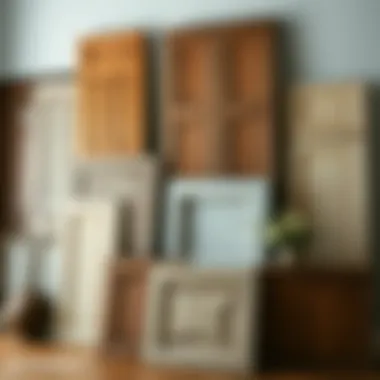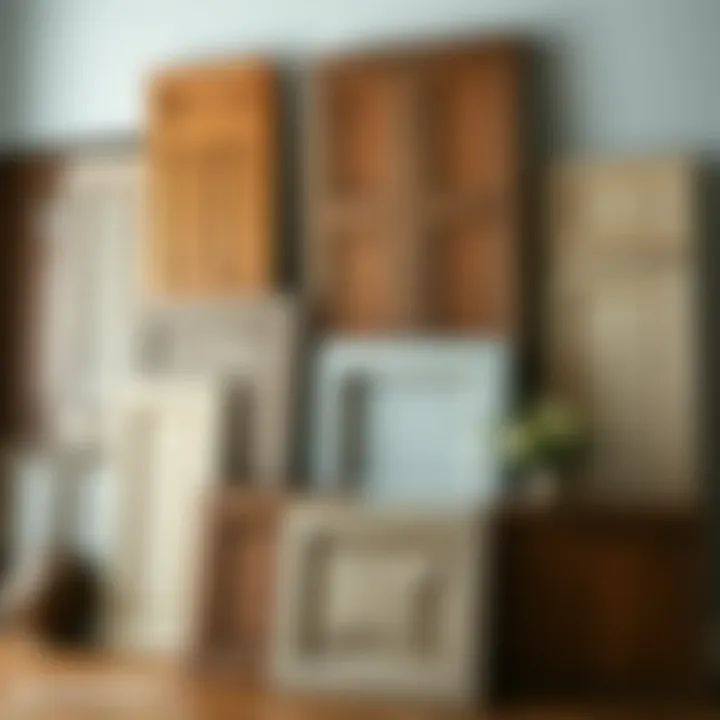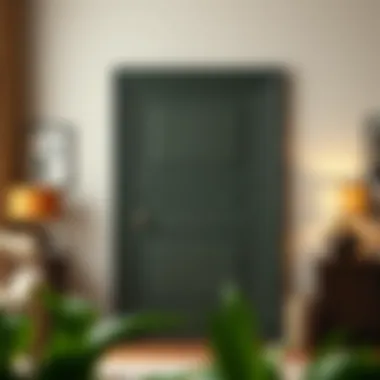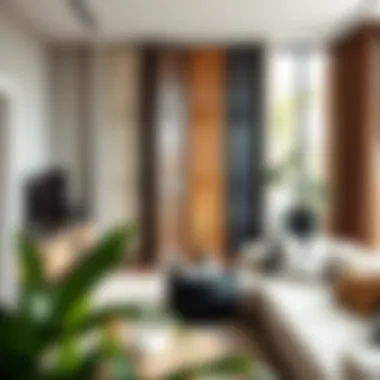Creative Uses for Used Cabinet Doors in Design


Intro
In the realm of home design, cabinet doors often sit quietly in the background, their potential overlooked by many. However, these components offer a treasure trove of opportunities for customization and creativity. With sustainability taking center stage in modern design practices, there’s never been a better time to explore the practicalities and aesthetic possibilities of used cabinet doors.
When one thinks about home renovation or furniture design, the idea of reusing materials may not be top of mind. But as homeowners and designers alike become more aware of environmental impacts, the trend to repurpose has grown significantly. This article is set to illuminate the undeniable appeal of used cabinet doors, highlighting not only their cost-effectiveness but also their versatility in a variety of interior settings. By tapping into innovative applications, this guide aims to inspire and equip you to enhance living spaces, combining both practicality and flair in your design decisions.
Understanding Used Cabinet Doors
Understanding used cabinet doors is crucial in exploring their myriad possibilities in the realms of home design and renovation. These elements do not just serve as functional components of cabinetry but also offer environmental and aesthetic benefits that resonate with modern sustainable living. It’s like finding a diamond in the rough, where the value of each door transcends its original intent, embodying an opportunity waiting to be unlocked.
Definition and Significance
Used cabinet doors are essentially discarded or outdated doors removed from kitchen, bathroom, and storage cabinets that can be salvaged for new purposes. Their significance lies primarily in their versatility and ability to contribute to both cost-effective renovations and unique home aesthetics. Homeowners and designers can repurpose these doors into new installations or even creative projects, tapping into a rich vein of creativity.
The existence of used cabinet doors plays into the larger narrative of sustainability. When one uses these doors, it decreases the demand for fresh materials, thereby reducing the overall carbon footprint associated with new product manufacturing and transport. In a time when our planet's resources are under continuous strain, embracing used materials becomes more than just a financial decision; it also reflects a conscientious choice for the environment.
Additionally, the significance of these doors extends to the character they can bring into living spaces. An antique or distressed cabinet door can evoke a sense of history, storytelling, and charm. Each door has its own narrative, marked by the wear and tear of daily use, which can become a conversation starter in your home. As they say, "one person's trash is another person's treasure," and this sentiment rings especially true in the case of used cabinet doors.
Historical Context
The journey of cabinet doors begins far earlier than our contemporary obsession with reuse. Historically, cabinet-making was an art form, where every piece shared insights into the craftsmanship of the era. There was a time when the materials available dictated the styles—cedar, oak, and pine were not just wood types; they represented the functionality and aesthetic preferences of specific periods.
In the mid-20th century, cabinetry took on a new flavor with the advent of mass production techniques, making cabinets more accessible to the average homeowner. However, with this accessibility came disposability. Post-renovation, many of these cabinets were tossed aside, leading to a growing waste problem. The push for sustainability sparked a renewed interest in salvage culture, where people began recognizing the potential of old cabinet doors and other discarded materials.
As time rolled on into the 21st century, the rise of DIY culture and the internet paved the way for creativity in reusing materials. Various communities sprang up sharing ideas and inspirations on how to integrate these components into new designs or refurbish them effectively. Websites like Reddit and Pinterest became treasure troves of information on creative applications for used cabinet doors, inspiring countless projects and innovative solutions. This shift highlights a significant evolution from the mere act of disposal to a focused approach of repurposing, illustrating our growing awareness of sustainable practices in everyday life.
Advantages of Using Used Cabinet Doors
Cost Savings
When it comes to home projects, cost is a major consideration for most people. One of the most immediate benefits of sourcing used cabinet doors is the substantial cost savings they can offer. Many homeowners delve into renovations with a fixed budget, and using these salvaged materials can make your dollars stretch much further. Compared to buying brand new cabinet doors, which can run into hundreds or even thousands of dollars, the price for reclaimed doors is often just a fraction of that.
You might find that a beautifully crafted, second-hand door can cost as little as 20% of its brand-new counterpart. This opens possibilities not only to save money but also to invest in other aspects of your project, such as high-quality hardware or better finishes. Moreover, purchasing used materials can sometimes lead to exceptional deals that you wouldn't encounter in retail. Whether you're browsing through local salvage yards or scrolling through online marketplaces, a little patience could lead to extraordinary finds at unbeatable prices.
Environmental Impact
In an age where sustainability is at the forefront of our priorities, the use of reclaimed materials like cabinet doors aligns perfectly with eco-friendly practices. By choosing to repurpose instead of purchasing new, you significantly reduce the demand for new manufacturing processes that often involve resource-intensive practices.
Using used cabinet doors contributes to waste reduction, as you prevent these materials from ending up in landfills. It’s estimated that more than 600 million tons of construction-related waste is generated annually in the United States alone. By opting for re-used cabinetry, you are taking a step towards a circular economy, where materials are kept in use, effectively minimizing your carbon footprint.
Furthermore, many manufacturing processes of new materials can release harmful substances into the environment, whereas used cabinet doors come with their history, often carrying the charm of their previous life without those negative impacts. You’re not just saving a small piece of history; you’re also doing your part for our planet.
Character and Uniqueness
Last but certainly not least, there's an unmatched charm in the uniqueness of used cabinet doors. Each piece carries its own history, soul, and often, distinctive character. This individuality can add a layer of warmth and personality that you simply cannot achieve with mass-produced cabinetry. In a world of cookie-cutter designs, opting for used materials allows for a special touch that tells a story.
You can mix and match styles to create a design that’s truly your own. Imagine using vintage cabinet doors in your kitchen to evoke a rustic farmhouse feel or utilizing ornate styles in a more modern setting, demonstrating that old can blend beautifully with new. This design flexibility can enhance the artistic expression within your living space and make it a reflection of who you are.
Sourcing Used Cabinet Doors
Finding used cabinet doors is an essential step for homeowners and DIY enthusiasts looking to save money and create unique pieces for their spaces. This part of the process is all about uncovering treasures that others may overlook. The significance lies not just in achieving a distinct aesthetic but also in promoting sustainability by diverting materials from landfills. As the saying goes, "One person's trash is another person's treasure." Understanding where to source these doors enhances your project’s potential while respecting the environment.
Local Salvage Yards and Reuse Centers
Visiting local salvage yards and reuse centers is like going on a treasure hunt. These places often stock a variety of materials salvaged from renovations, making them a goldmine for finding used cabinet doors. Not only can you expect to find well-crafted wood, but you might also stumble upon unique styles that add character to your home.
Benefits of sourcing from local salvage yards include:
- Cost-Effective Options: Often, prices are substantially lower than typical retail.
- Ecological Impact: Shopping here supports local recycling efforts.
- Personal Connection: Engaging with local businesses fosters community support.
It’s wise to call ahead or check social media pages to see what’s in stock. Often, dealers list inventory online, saving time and effort for targeted searches. When you visit, don't hesitate to inquire about anything that catches your eye. The personnel are usually knowledgeable and can help guide you toward the best fits for your project.


Online Marketplaces and Auctions
For those with a broader reach, online marketplaces present another viable route. Websites like eBay, Craigslist, and Facebook Marketplace are rife with opportunities. The allure of online sourcing is the sheer variety available. You can filter searches by style, size, and price range, making it easier to pinpoint exactly what you need without the limitations of geographical location.
Things to consider when shopping online:
- Quality Check: Always request additional pictures and details about the doors’ conditions.
- Shipping Costs: Some sellers charge exorbitant fees for shipping, so calculate these into your budget.
- Potential for Bargaining: Much like in-person negotiations, there might be room to haggle, so don't be shy.
Online auctions also provide a unique platform. They allow for more dynamic pricing and the chance to bid on desirable items, which can lead to great deals if you play your cards right. Just remember to set a maximum price to avoid impulse buying.
Networking with Contractors and Designers
Creating a network of contractors and designers can unlock doors (quite literally). Individuals in these professions often have access to surplus materials from their projects and may be willing to pass along used cabinet doors. They might have leftovers from jobs that didn’t make it to the customer’s home or be aware of other clients looking to offload materials.
Here’s how you can build these connections:
- Attend Local Home Improvement Events: Trade shows, workshops, and community meetings are great venues to meet professionals.
- Utilize Social Media: Joining local community groups or forums can bring visibility to your needs.
- Word of Mouth: Simply asking around among friends and family can lead to unexpected leads.
By establishing these relationships, not only do you increase your chances of sourcing quality materials, but you also tap into a pool of expertise that can offer advice on restoration and design integration.
"Finding the right materials can make or break a project. It's worth the effort to source thoughtfully."
Through local salvage yards, online marketplaces, and industry networking, sourcing used cabinet doors can be an enriching experience that supports personal creativity while retaining a commitment to sustainability.
Restoring Used Cabinet Doors
Restoring used cabinet doors can be an enriching adventure, where creativity meets practicality. This segment not only serves to beautify home spaces but also extends the lifespan of these materials, ensuring they don’t end up in landfills. When correctly restored, used cabinet doors offer equal aesthetic value as new ones, all while slashing costs and promoting sustainability. A homeowner or designer can breathe new life into cabinetry that might otherwise seem outdated or worn, turning it into a stunning focal point. Let’s walk through the essential aspects of restoring these treasures, focusing on assessing their condition, cleaning them, and repairing any imperfections.
Assessment of Condition
Before diving into restoration, it’s crucial to assess the condition of the cabinet doors. This step is akin to a doctor examining patients; without a thorough check-up, one might overlook underlying issues. Pay close attention to factors such as:
- Surface Damage: Look for scratches, dents, or chips that could affect the finish.
- Structural Integrity: Ensure hinges are functional and that the wood isn't warped or rotting.
- Finish Degradation: Signs of peeling or fading paint can indicate a need for refinishing.
By evaluating these elements, you can determine the extent of restoration needed. A simple cleaning may suffice, but more extensive damage might require refinishing or even replacing parts. Remember, each cabinet door has a story; assessing its condition helps understand that narrative and plan the right revival.
Cleaning and Refinishing Techniques
Once you've established their condition, cleaning and refinishing become your next steps. This part of the process can be surprisingly satisfying, as it rewards your efforts with a visible transformation. Follow these techniques:
- Initial Cleaning: Use warm, soapy water to gently scrub the surfaces. Avoid harsh chemicals that could damage the wood.
- Deep Clean: For sturdier dirt, mix vinegar and water, which can effectively cut through grease and grime. For stubborn residues, consider a specialized wood cleaner.
- Sanding: Get rid of any old finish by sanding the surface lightly. This can prepare the wood for a new coat of stain or paint. Use a finer grit for a smooth finish.
- Refinishing: After sanding, you can apply your chosen stain or paint. If opting for paint, a primer may be necessary to ensure adherence and richness in color.
By undertaking these cleaning and refinishing processes, the cabinet doors can look vastly different, often resembling new pieces of art.
Repairing Damaged Areas
Damage is par for the course with used cabinet doors, but many issues can be repaired with a little elbow grease. Addressing these areas can involve several steps:
- Filling Gaps or Cracks: Use wood filler to address any openings. Ensure it's smooth to allow easy sanding.
- Replacing Hardware: Sometimes, hinges, knobs, or handles might need updating. Consider swapping them out for modern alternatives to enhance the overall look.
- Strengthening Structure: If the integrity of the door is compromised, consider reinforcing it with brackets or replacing any weak joints.
This careful attention to repair ensures that the cabinet doors not only look good but also remain functional for years to come.
"One man's junk is another man's treasure" is never truer than in the realm of cabinet doors. With a bit of creativity, the mundane can transform into the magnificent.
With these restoration tips, used cabinet doors can become a remarkable addition to your living space, emphasizing both resourcefulness and style.
Creative Applications of Used Cabinet Doors
Used cabinet doors hold more potential than just serving their original function. They represent a tapestry of creativity that homeowners, designers, and decorators can unfold in various inventive ways. These applications don’t just offer a practical solution; they invite artistic expression and make a statement about sustainability that resonates deeply in today's world. By transforming used cabinet doors into new items, the possibilities are limitless—inviting both utility and aesthetic appeal into your spaces.
Furniture Projects
One of the most favored ways to utilize used cabinet doors is within furniture creation. With a little creativity and elbow grease, what was once a plain cabinet door can morph into stunning pieces that elevate any room.


Here are some notable furniture ideas:
- Coffee Tables: Combining multiple cabinet doors can create an eye-catching coffee table. Add hairpin legs or traditional wooden legs to support the structure, and you’ve got a chic piece that stands out in any living room.
- Benches: Attach two or three cabinet doors side by side, add some cushion on top, and you'll have a beautiful, unique bench. This can become a focal point in an entryway or a practical seating option for your kitchen nook.
- Headboards: For a rustic or vintage bedroom design, old cabinet doors can be aligned to form a creative headboard. Stain or paint it to match your existing decor, and you won’t just have a sleeping area; you’ll have a statement piece.
These projects remind us: furniture can be both functional and uniquely artistic, showcasing personal style while promoting reuse.
Wall Art and Decorations
Transforming cabinet doors into wall art is a game changer for any home decorator. Instead of tossing these items into the landfill, you can breathe new life into them, making your walls speak volumes.
Consider these ideas:
- Artistic Displays: Sand down the surface of a door and paint it with a vibrant hue. It can act as a canvas for abstract designs or a mural, lifting the atmosphere of your living space.
- Photo Frames or Shelves: Cut and frame a door to create a gallery-style display for your favorite photos or art pieces. Alternatively, you can modify a cabinet door into a small shelf, ideal for showcasing knick-knacks or potted plants.
- Mirrors: If the cabinet doors come with a frame, inserting mirrored glass can turn the door into a stunning mirror, perfect for adding depth and light to a room.
Utilizing cabinet doors for decorative purposes not only serves as a talking point but also emphasizes the importance of artistry and creativity in personal spaces.
Storage Solutions
Storage is often a puzzle many homeowners face. Used cabinet doors can be ingeniously repurposed into space-saving storage solutions.
Think about these options:
- Wall-Mounted Organizers: Attach cabinet doors vertically on the wall. They can turn into unique wine racks, spice racks, or even a simple display for items like mail and keys. This eliminates clutter while keeping essentials organized and within reach.
- Under-Bed Storage: Fashion the cabinet doors into shallow containers or boxes that fit under your bed, utilizing otherwise wasted space for storage of seasonal clothes or extra linens.
- Kitchen Dividers: Convert smaller cabinet doors into dividers for cabinets, helping to keep pots, pans, and dishes from tumbling over each other.
With a dash of creativity, your house can become a well-organized haven, while maintaining a stylish look, all thanks to the charm of used cabinet doors.
"The art of repurposing is like sculpting; it takes vision and a bit of finesse, turning the ordinary into something spectacular."
The creative applications of used cabinet doors not only illustrate the benefits of sustainability but also enhance the aesthetic appeal of your home. Every transformed piece tells a story of its journey from one form to another, adding layers of texture and character that new items can rarely replicate.
Integrating Used Cabinet Doors into Interior Design
Integrating used cabinet doors into interior design is not just about aesthetics; it’s about weaving functionality and individuality into the fabric of a space. With the rising interest in sustainable living, many homeowners and designers are exploring innovative ways to repurpose materials that have been dismissed as mere leftover artifacts. The importance of this subject lies in its capacity to breathe fresh life into a home while inspiring creative expression.
Stylish Kitchen Renovations
Kitchens often serve as the heart of a home, an epicenter for gathering and culinary creations. Incorporating used cabinet doors in kitchen renovations can lead to stunning transformations that combine modern needs with rustic charm. For instance, replacing standard cabinet fronts with vintage or reclaimed doors can create a lively focal point.
- Custom Design Options: Homeowners can customize cabinet doors to match their personal style. Paint, stain, or some intricate carving can provide character, making the kitchen uniquely theirs.
- Economical Choices: Renovating with used doors is an attractive option for those watching their dollars. High-quality doors from high-end cabinetry can often be found for a fraction of the original cost at salvage yards.
- Visual Interest: Shifting from traditional cabinetry to eclectic door styles introduces a fresh dynamic within the kitchen. Pairing a weathered, antique door with sleek, modern fixtures can be a conversation starter while elevating the overall decor.
Unique Bathroom Designs
The bathroom is often overlooked when it comes to using reclaimed materials, yet it presents a charming opportunity to make a bold statement. Used cabinet doors can lend a rustic touch or become a focal point depending on their treatment.
- Sinks and Vanities: Imagine a beautiful vanity made with old cabinet doors, complementing the flow of the room while decisively standing out. A farmhouse-style sink against a backdrop of vintage doors can evoke a sense of serenity.
- Storage Solutions: By integrating cabinet doors as part of wall-mounted storage or as decorative panels, one can achieve a tidy and pleasing aesthetic. The versatile designs available allow for enhanced storage without sacrificing style.
- Theme Coordination: Whether aiming for a spa-like retreat or a quirky bohemian vibe, used cabinet doors can be adapted to fit various themes. They're easily stained or painted, making them incredibly flexible in aligning with desired aesthetics.
Living Room Enhancements
The living room, often the social hub of a home, is an ideal space for showcasing creativity. Using cabinet doors can enhance this room in ways that reflect personal taste and functionality.
- Accent Walls: A wall adorned with a patchwork of different cabinet doors can add texture and visual depth, serving not only as decoration but as an art installation in its own right.
- Coffee Tables or Media Centers: Crafting furniture from used cabinet doors can yield bespoke pieces that fit snugly into any desired layout. A coffee table with built-in storage can help keep clutter at bay while looking stylish.
- Dividers or Shelving Units: Create stylish room dividers or open shelving structures using cabinet doors. This can help delineate spaces while adding creative storage solutions.
Integrating used cabinet doors into living spaces not only enhances aesthetic appeal but also provides functional benefits, making them an ideal choice for any home décor project.
Challenges and Considerations
When it comes to embracing the world of used cabinet doors, it’s crucial to navigate the potential challenges and considerations that come hand in hand with the benefits. Understanding these factors can significantly influence the success of your project and the overall satisfaction with the final outcome.
Time and Labor Investment
Diving into the realm of used cabinet doors often demands a good amount of time and labor. Unlike brand new installations, working with salvaged materials requires careful consideration and sometimes, elbow grease. To begin with, there's assessment and planning. Every door needs a thorough evaluation, with attention to its condition, suitability, and compatibility with your existing space.
Once you’ve selected the doors, you may find yourself going down the rabbit hole of restoring and refinishing. This could mean sanding, repainting, or even restructuring for better fit and finish. Not to forget, each step can vary in complexity: some surfaces may need deep cleaning or extensive repairs, while others might just need a quick coat of polish.


Your available time can also dictate how ambitious your project becomes. Can you devote weekends to refinishing, or are you looking for a more instant gratification approach? The balance between your vision and the reality of your schedule can impact not only your project timeline but also your overall satisfaction with the completed work.
Having the right tools on hand, such as sanders, paints, and sealers can also enhance efficiency. In this regard, planning is key. If you can map out steps in advance, you can save yourself from some trial and error. A solid plan not only streamlines the process but keeps you motivated to see the project through to the end.
Compatibility with Existing Decor
The next hurdle in working with used cabinet doors is ensuring they meld seamlessly with your existing decor. Integrating these unique pieces requires a keen eye for detail and a good understanding of your space’s aesthetics.
Firstly, consider the style and finish of the cabinet doors. A rustic barn door look might not align well with sleek, contemporary decor. The colors, textures, and materials should ideally complement your existing furnishings. Mixing styles can create striking contrast but also risks visual disarray. It’s essential to visualize how these used doors will harmonize—or clash—with your current theme.
Here are some elements to keep in mind:
- Materials: Wood tones, metal, or glass can differ in how they mesh with furniture and decor.
- Color Palette: Look for hues that are in line with your wall colors and other furniture.
- Textures: Smooth finishes can clash with rough ones; maintaining a balance creates an inviting atmosphere.
Accessorizing can also play a significant role in bridging any potential gaps and unifying the look. Incorporating fabrics, artwork, or accents that share common colors or textures can help create that cohesive vision you’re aiming for.
Navigating this compatibility landscape might seem daunting, yet it can also be an opportunity to exercise creativity and make your space truly unique.
"The beauty of a home lies not just in the materials but in the heart you put into creating harmony within it."
In summary, recognizing challenges such as time investment and compatibility with existing decor is essential for making informed decisions about using used cabinet doors in your interiors. With planning and creativity, these challenges can turn into opportunities for personal expression in your living space.
Sustainability and the Future of Used Materials
Sustainability has moved from being a buzzword to a fundamental aspect of our daily lives. With growing environmental concerns, the importance of sustainability in design and renovation has never been so prominent. When it comes to materials like used cabinet doors, promoting their reuse or repurposing not only benefits individual homeowners but also addresses broader environmental issues. It’s clear that incorporating used materials can significantly reduce waste and lower our carbon footprint while still enhancing the aesthetic qualities of our living spaces.
Broader Environmental Trends
In recent years, we have witnessed an increasing awareness surrounding environmental issues that ******goes beyond immediate utility. The push towards reduced waste has prompted homeowners and designers alike to look for alternatives to new materials, which often rely on resource-intensive production processes. Here are some key trends reflecting this shift:
- Minimalism and Functional Design: Many people are favoring simpler living spaces, which often leads to a reevaluation of furniture choices. Using cabinet doors in creative ways aligns perfectly with minimalistic styles—all while keeping practicality in focus.
- Local Sourcing: There's a trend toward sourcing materials locally to cut down on greenhouse gas emissions associated with transporting goods over long distances. Used cabinet doors sourced from local salvage yards or marketplaces minimize the environmental impact.
- Awareness Campaigns: Organizations are actively advocating for sustainable practices. Educational resources, social media, and workshops help spread the knowledge about the benefits of using second-hand materials, influencing more consumers to consider alternatives.
These trends are not just passing fancies—they represent a significant change in consumer behavior. People are increasingly looking for ways to make their homes not just stylish but also environmentally conscious.
The Role of Repurposing in Circular Economy
The notion of a circular economy revolves around the idea of keeping materials in use for as long as possible. By repurposing used cabinet doors, we contribute to this economic model in several meaningful ways:
- Waste Reduction: Instead of sending discarded furniture to landfills, repurposing extends the life of materials. By finding new applications for used cabinet doors, we drastically reduce waste.
- Value Creation: Once regarded as 'waste,' used cabinet doors can turn into bespoke furniture pieces or interior accents through repurposing. This transformation not only brings new life to the materials but also lets homeowners add a unique touch to their spaces.
- Community Engagement: The practice of repurposing often involves local communities. Workshops and DIY groups help foster skills among members, creating a sense of togetherness around sustainability.
Each repurposed cabinet door essentially becomes a part of a larger narrative—one that champions sustainability, craftsmanship, and creativity.
"Sustainability isn’t just a destination but a continuous journey. Using materials like used cabinet doors can significantly enrich that journey."
As consumers, we have the power to shape market dynamics by choosing items that follow ethical and sustainable practices. With thoughtful choices, each of us can contribute to a future that prioritizes both beauty and sustainability, one cabinet door at a time.
Finale and Future Prospects
As we draw this exploration of used cabinet doors to a close, it becomes clear that these seemingly mundane materials hold a wealth of potential. The importance of this topic lies in its intersection of practicality, sustainability, and creativity. Through the various sections of this article, we've illuminated not only the benefits that come from utilizing used cabinet doors but also their role in shaping our environmental future.
In summary, we can see how adopting used cabinet doors as a sustainable resource offers a multi-faceted approach to home renovation and design. This practice not only curtails waste and conserves resources but also opens up avenues for unique aesthetics in interior spaces. Moreover, the concept of reusing materials aligns with the growing global movement towards sustainability, making it a relevant and prominent aspect of modern design.
Some key elements that stand out include:
- Cost-effectiveness: Using pre-owned materials often reduces expenses in home projects.
- Character and uniqueness: Each door carries its own story, making designs one-of-a-kind.
- Environmental consciousness: Following a sustainable path contributes to a healthier planet.
Recap of Key Points
Throughout our journey, several key points have emerged that underline the value and versatility of used cabinet doors.
- Understanding the historical context and significance unveils the richness of these objects.
- Highlighting the advantages, such as cost savings and environmental impact, emphasizes why homeowners should consider this route.
- Sourcing through local salvage yards and online avenues opens up plentiful opportunities.
- Techniques for restoration empower individuals to breathe new life into these doors, showcasing creativity at its finest.
- The various creative applications transform these doors into functional art throughout the home.
- Integration into specific design settings underscores their adaptability, enriching living spaces across various aesthetics.
- Navigating challenges allows homeowners to make informed decisions, ensuring compatibility with current decor.
Encouragement for Exploration
In closing, let’s challenge ourselves to think outside the box. Used cabinet doors are not merely remnants of another time; they are opportunities waiting to be seized. Whether you consider yourself a DIY enthusiast or a seasoned designer, there’s an expansive horizon to explore when it comes to integrating these materials into your life.
I urge you to venture into local salvage yards or peruse online marketplaces. Engage with your network of contractors and designers who may have insights or leads on available doors. Experimenting with restoration techniques is a hobby that can yield unexpected and satisfying results. Allow yourself to envision their potential beyond traditional applications—think outside the standard; embrace the unique.
In a world increasingly defined by sustainability, the choice to utilize used cabinet doors serves as a testament to environmentally conscious decision-making. So roll up your sleeves and embark on this innovative journey. The future of design could very well lie in the hands of those who dare to reuse and repurpose.



